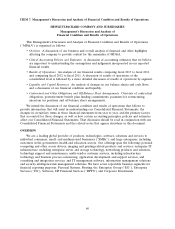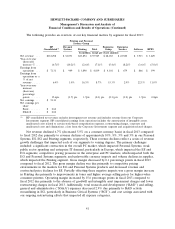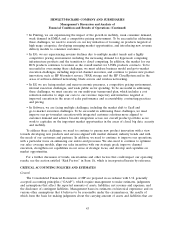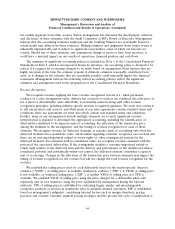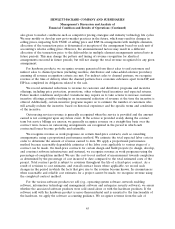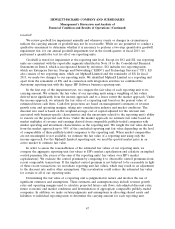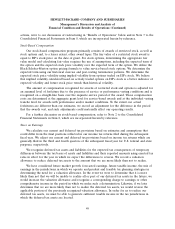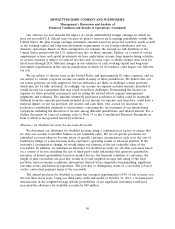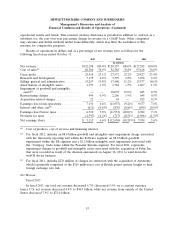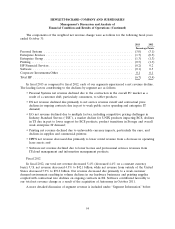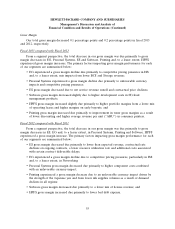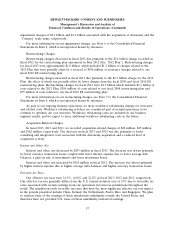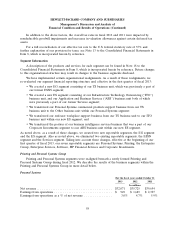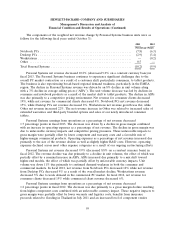HP 2013 Annual Report Download - page 57
Download and view the complete annual report
Please find page 57 of the 2013 HP annual report below. You can navigate through the pages in the report by either clicking on the pages listed below, or by using the keyword search tool below to find specific information within the annual report.HEWLETT-PACKARD COMPANY AND SUBSIDIARIES
Management’s Discussion and Analysis of
Financial Condition and Results of Operations (Continued)
actions, refer to our discussions of restructuring in ‘‘Results of Operations’’ below and in Note 7 to the
Consolidated Financial Statements in Item 8, which are incorporated herein by reference.
Stock-Based Compensation
Our stock-based compensation program primarily consists of awards of restricted stock, as well as
stock options and, to a lesser extent, other award types. The fair value of a restricted stock award is
equal to HP’s stock price on the date of grant. For stock options, determining the appropriate fair
value model and calculating fair value requires the use of assumptions, including the expected term of
the option and the expected stock price volatility over the expected term of the option. We utilize the
Black-Scholes-Merton option pricing formula to value service-based stock options. We determine the
expected term using our historical exercise and post-vesting termination patterns. We determine the
expected stock price volatility using implied volatility from options traded on HP’s stock. We believe
that implied volatility calculated based on actively traded options on HP’s stock is a better indicator of
expected volatility and future stock price trends than historical volatility.
The amount of compensation recognized for awards of restricted stock and options is adjusted for
an assumed level of forfeiture due to the presence of service or performance vesting conditions and is
recognized on a straight-line basis over the requisite service period of the award. These compensation
costs are determined at the aggregate grant level for service-based awards and at the individual vesting
tranche level for awards with performance and/or market conditions. To the extent our actual
forfeitures are different than our estimates, we record an adjustment for the difference in the period
that the awards vest, and such adjustments could materially affect our operating results.
For a further discussion on stock-based compensation, refer to Note 2 to the Consolidated
Financial Statements in Item 8, which are incorporated herein by reference.
Taxes on Earnings
We calculate our current and deferred tax provisions based on estimates and assumptions that
could differ from the final positions reflected in our income tax returns filed during the subsequent
fiscal year. We adjust our current and deferred tax provisions based on income tax returns which are
generally filed in the third and fourth quarters of the subsequent fiscal year for U.S. federal and state
purposes, respectively.
We recognize deferred tax assets and liabilities for the expected tax consequences of temporary
differences between the tax bases of assets and liabilities and their reported amounts using enacted tax
rates in effect for the year in which we expect the differences to reverse. We record a valuation
allowance to reduce deferred tax assets to the amount that we are more likely than not to realize.
We have considered future market growth, forecasted earnings, future taxable income, the mix of
earnings in the jurisdictions in which we operate and prudent and feasible tax planning strategies in
determining the need for a valuation allowance. In the event we were to determine that it is more
likely than not that we will be unable to realize all or part of our deferred tax assets in the future, we
would increase the valuation allowance and recognize a corresponding charge to earnings or other
comprehensive income in the period in which we make such a determination. Likewise, if we later
determine that we are more likely than not to realize the deferred tax assets, we would reverse the
applicable portion of the previously recognized valuation allowance. In order for us to realize our
deferred tax assets, we must be able to generate sufficient taxable income in the tax jurisdictions in
which the deferred tax assets are located.
49



